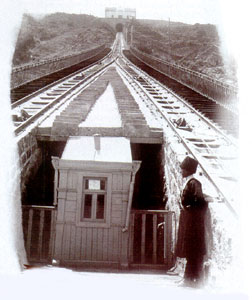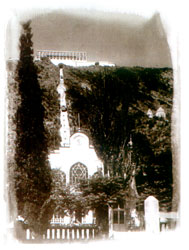

The Encyclopedia provides the following definition of the word "funicular": funicular (from Latin funiculus rope) is a railway up the side of a mountain, consisting of two counterbalanced cars operated by a cable to carry passengers and freight over a steep slope.
The Tbilisi Funicular is also a mountainous cable-operated railroad with upper and lower stations.
But the word Funicular has acquired an additional connotation – it has become a Tbilisi toponym, similar to Kala, Ortachala, Sololaki, Vera, etc… When we mention the Funicular, the Mount of Mtatsminda, the Mamadaviti Church and the Pantheon immediately appear in front of us. This is how the Funicular has become a historical monument and a place where Tbilisi can be viewed with a special charm and beauty.
A little bit of its history:
The Tbilisi Funicular was constructed to develop the Mtatsminda plateau. In the second half of the 19th century, when the borders of old Tbilisi expanded and the construction of "European Tbilisi" commenced on the Golovin Avenue (today’s Rustaveli Avenue), a decision was made to develop the Mtatsminda plateau. At that time, Mtatsminda was "a no man’s land", an uninhabited place "where over the distance of several miles your sight would catch neither a tall tree nor a mere shrub". To go up the hill, first it was necessary to build a road. The most suitable way to do so was a cable railroad, or a funicular. At that time, such roads were constructed in many countries and enjoyed immense popularity.
With regard to the construction of the Funicular, the opinion of the community was varied. At the City Council meeting, one of the "voters" declared: "Such a structure is an object of luxury. The Funicular can be built in Tbilisi when the city enjoys full prosperity. And this will probably happen in 1000-years time." In spite of the controversy, it was decided to build the Funicular and the construction was completed in record time.
The construction of the Funicular was headed by the Tbilisi "Konki" governor, a Belgian engineer Alphons Robie who was a representative of the anonymous Belgian society. In 1896, Alphons Robie proposed the idea of building the Funicular. He presented his proposal to the city self-governance, requesting permission for laying the cable railroad.
In July 1900, the city municipal authorities signed the order for the construction of the Funicular in Tbilisi, thus approving the project of the Belgian engineer. The construction was to begin from the foot of the mountain where the city water reservoir was positioned and was to be completed at the mountain top, at the so-called "hermit’s head".
Pursuant to the agreement, the Belgian Anonymous Society was granted the right to operate the Funicular for a period of 45 years, and after the expiration of that period, they would give the rights to the city. The same document envisaged the construction of an electric railroad between Mtatsminda and the village of Kojori. In 1908, Alphons Robie obtained permission to lay the railroad from the Funicular upper station to Kojori. The contract was concluded, the appropriate funds were allocated, but due to various reasons, this project never materialized.
The construction of the Funicular began in September 1903. Many foreigners took part in its realization: the project was designed by a French engineer, A. Blanch and was architecturally elaborated by a Tbilisi architect, Alexander Shimkevich. Shimkevich was a famous architect, Polish by nationality. It was by his designs that the buildings of the Rustaveli Theatre, the Tbilisi Conservatory, the Supreme Court and numerous residential houses were built. The road construction was headed by a Belgian engineer, I.Ragoler, assisted by an Italian engineer, A. Fontana-Rossi, who was invited by the Belgian Anonymous Society. Antonio Fontana-Rossi died in 1905, soon after the completion of the Funicular. He was buried at Kukia cemetery. After her husband’s death, Mrs. Fontana-Rossi returned to her homeland. In June 1969 Delphina, Antonio Fontana-Rossi’s younger daughter who was born in Tbilisi, visited her father’s grave (M. Chorgolashvili. "Mtatsminda", 1979, p. 32).
With the permission of the city authorities the Funicular Society launched an electric tram from the Funicular lower station to Erevan Square (today’s Freedom Square) to link the city center with the Funicular and to carry passengers.
Niko Nikoladze, a renowned public figure of Georgia, had immensely contributed to the Funicular construction. It was on his initiative and active support that the concrete works were undertaken for the Funicular elevated railroad (the bridge-like structure on which the railroad runs).
The construction of the Funicular was basically finished by the end of 1904 (this date is also indicated on the Funicular rail tracks).
On 25 February 1905, the newspaper "Iveria" wrote: "Yesterday the Gubernia (Province) Technical Commission examined the Mtatsminda Funicular in the presence of the city engineers. The Commission commended the road leading to the top and the equipment thereof, having granted permission to launch the facility. According to the Commission, the carriage will take six minutes for ascent and descent. The Commission was also pleased with the machine-brakes designed to stop the carriage on its way from the top. After using the brakes, the carriage stopped immediately.

The carriage will accommodate 50 persons. The price of 20 kopecks for going up and coming down has also been set."
A special commission checked the technical side of the mountainous-cable
railroad of the Funicular, its conditions of operation, and issued a permit
for launching.
On 27 March 1905, at 10 in the morning, following a celebration, the
Tbilisi Funicular was launched. At the opening ceremony, the Mamadaviti
Church priest, N. Macharashvili, made a speech thanking the builders and
the planners for bringing such a great work to a successful end. The mayor
cut a blue ribbon and declared the road open.
Vaso Kvavilashvili, the first locomotive-driver of the Funicular recalls: "At first people feared that the rope might break and they did not want to climb into the carriage. People were brought in coaches, were paid money, and were urged not to be afraid and to get into the carriage. Later, when people got used to the railroad, there was a long line for tickets."
Opening of the Funicular was a special event in the life of our capital.
The community expressed enormous satisfaction and joy in connection with
this event. Niko Pirosmanishvili dedicated a wonderful painting commemorating
the event. Dimitri Ermakov, a renowned photo-artist, took photos of the
old Funicular, preserving them for the future generations (they showed
the interior and exterior of the Funicular, machines and equipment, and
the beauties of the Mtatsminda panorama).
Four-thousand rubles were spent on the Funicular construction. The
length of the road is 501 meters. The sloping angle of the railroad line
- 28-33 degrees. At the very beginning, the carriage was made up of three
compartments which could accommodate eight passengers each. The carriage
had two platforms for 24 passengers. Subsequently, these two platforms
were transformed into compartments and long benches were installed.
The weight of a carriage was up to 250 poods (4,000 kilograms) each. In
the middle of the road, there was a special platform arranged for the carriages
to let them pass each other on their way. From here, the passengers could
access the Mtatsminda Pantheon.
The upper station of the Funicular is at an altitude of 727 meters above sea level and the lower station – at 460 meters.
The first reconstruction of the Funicular took place in 1936-1938. Instead of the old station a new, three-storey building was built – the one that our generation still remembers for its grandeur and beauty.
In 1937, a wide highway was built to go up Mtatsminda Mountain. The highway branched off from the Kojori road and ran across Okrokana.
The second reconstruction of the Funicular took place in 1968-1969. This time, a new building was built at the lower station to replace the old one and the carriages were modified. The Tbilisi State Art Academy presented an original structural model for the new carriages. The square providing access to the Funicular was expanded.
The number of the population of the capital and that of the tourists visiting the city was growing rapidly and the mountain’s cable car (the funicular) could no longer meet the emerging requirements. Therefore, it was decided to build an aerial cable car as well.
In 1958, in connection with the 1500th anniversary of the capital, construction of the first aerial cable car in Georgia began. It was launched in October of the same year and for a long time made the Tbilisi residents and visitors very happy. And then… You know yourselves what happened later.
Today "a different" and most beautiful structure of the cable car - the Funicular building, that has become a Tbilisi symbol and is so dear to the hearts of all of the Tbilisi dwellers is again waiting for the restorer and supporter. And so is the beautiful Mtatsminda Park.
From January 1, 1957, a television tower was erected on the Mount of Mtatsminda. At this very place, the first Georgian television studio was launched. In the beginning, the Tbilisian residents could not get used to the strange structure erected on Mamadaviti Mountain. Probably, just like the French at the time of construction of the Eiffel Tower.
A French botanist, Emil Levie wrote this about Tbilisi: "In the evenings, the city is a wonderful sight from the top. I feel as if I am looking at Paris from the top of the Eiffel Tower".
Why not? Perhaps sometime in the future someone else will write something similar…
MZIA KUTSNIASHVILI